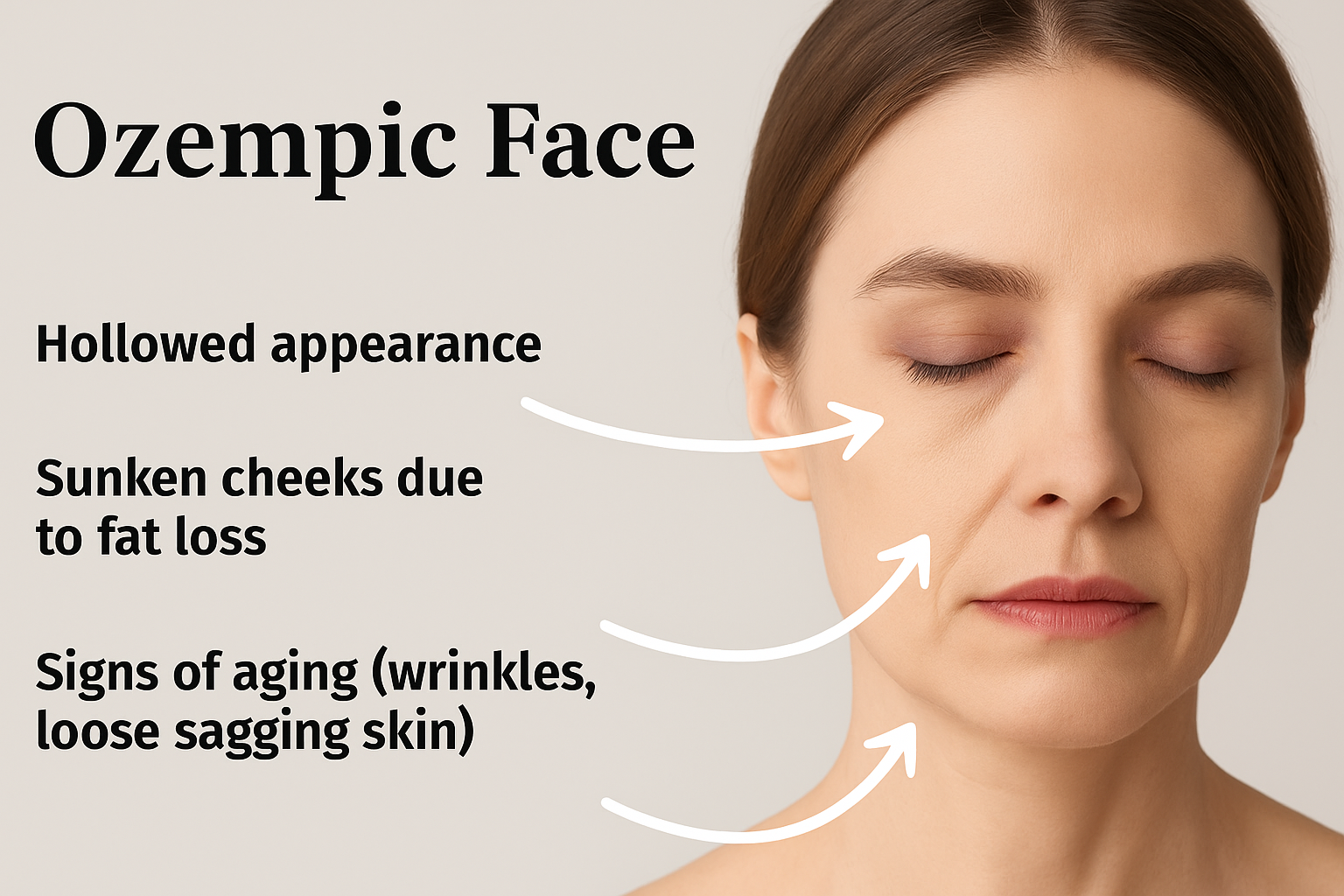What to Do About Sagging Skin and “Ozempic Face” After Major Weight Loss on GLP-1 like Wegovy and Zepbound

Losing a significant amount of weight is a major personal victory—especially when it means improved health, reduced risk of chronic disease, and renewed energy. Medications like Ozempic, Wegovy, and Zepbound (part of the GLP-1 class) are helping millions reach their weight loss goals faster than ever before.
But with that rapid transformation often comes something few people expect: loose, sagging skin and facial changes that some have dubbed “Ozempic Face.”
If you’re dealing with these side effects, you’re not alone—and more importantly, you have options.
This article will walk you through what causes these changes, what treatments are available (surgical and non-surgical), and how to protect your confidence, your health, and your investment in yourself.
Understanding “Ozempic Face” and Skin Sagging
“Ozempic Face” is a term popularized by media and cosmetic surgeons to describe the gaunt, hollowed, and aged look that can appear in the face after significant weight loss with GLP-1 medications like semaglutide. It’s not unique to Ozempic—similar effects occur with any form of rapid weight loss, including bariatric surgery or crash diets.
These facial changes usually stem from volume loss in key fat pads—especially in the cheeks, temples, and jawline. As fat melts away, the skin doesn’t always snap back, particularly if elasticity is already diminished due to aging or long-term obesity. This can leave people with deepening wrinkles, hollow cheeks, and skin that appears to “melt” or sag downward.
The same process can happen elsewhere on the body, leading to loose skin on the arms, abdomen, thighs, buttocks, and neck. This isn’t just a cosmetic issue—excess skin can cause discomfort, hygiene challenges, and emotional frustration.
Why Does This Happen?
1. Rapid Fat Loss
GLP-1 medications work by mimicking the hormone that helps you feel full, slow digestion, and reduce cravings. As a result, many people lose weight quickly—often 15–20% of their body weight in a year.
But your skin is used to having more volume underneath it. When fat disappears too fast, the skin may not have time to contract and reshape.
2. Decline in Collagen and Elastin
The proteins that give skin its bounce—collagen and elastin—naturally decline with age. Rapid weight loss accelerates this mismatch between the inner volume and outer envelope, leaving the skin loose.
Some researchers suggest that GLP-1 drugs may even reduce the activity of cells that produce collagen and elastin, which could further limit the skin’s ability to rebound.
3. Other Factors That Affect Skin Tightness
- Age: Older individuals have less elastic skin.
- Genetics: Skin thickness and collagen content vary by individual.
- Duration of obesity: Skin stretched for long periods is less likely to shrink back.
- Lifestyle: Poor hydration, low protein intake, and lack of strength training can worsen sagging.
How Common Is It?
You are not alone in this experience.
- About 48% of GLP-1 users report noticeable facial changes.
- Over 60% cite skin sagging as their number one post-weight loss concern.
- Some users notice changes within just 2–3 months of starting treatment.
Because so many people are experiencing these effects at once, plastic surgeons report a 50% increase in fat grafting procedures—specifically to correct facial hollowing caused by GLP-1 weight loss.
Treatment Options: What You Can Do
There is no one-size-fits-all solution. But based on how much skin laxity you’re dealing with, you can choose between surgical, non-surgical, and lifestyle interventions—or a combination.
Surgical Options (for Moderate to Severe Skin Sagging)
If you’ve lost a significant amount of weight and are dealing with loose skin that interferes with comfort, mobility, or confidence, surgery may be the most effective route.
Common procedures include:
- Facelift or Neck Lift: Corrects sagging jowls, deep folds, and neck laxity.
- Tummy Tuck (Abdominoplasty): Removes extra skin and tightens abdominal muscles.
- Arm Lift (Brachioplasty): Reduces “bat wings.”
- Thigh Lift: Improves contour of inner or outer thighs.
- Lower Body Lift: Comprehensive procedure to address abdomen, flanks, and buttocks.
- Fat Grafting: Adds volume back to cheeks or buttocks using your own fat.
Recovery time can range from 2 to 6 weeks. Costs vary widely, from $6,000 for a single procedure to over $50,000 for full-body contouring.
Note: Some insurance plans may cover a panniculectomy (removal of abdominal skin) if it causes rashes or infections. Most other procedures are considered cosmetic.
Important: Patients on GLP-1 medications must usually pause treatment for several weeks before surgery. These drugs slow digestion, which can increase anesthesia complications. They may also raise the risk of delayed wound healing.
Non-Surgical Treatments (for Mild to Moderate Concerns)
Not ready for surgery? Many people find relief with less invasive options.
Injectable Fillers
- Hyaluronic acid fillers (like Juvederm or Restylane): Restore volume to cheeks and lips.
- Biostimulatory fillers (like Sculptra or Radiesse): Stimulate your own collagen over time.
Results last 6 months to 2 years. Prices range from $600 to $1,200 per syringe.
Energy-Based Skin Tightening
- RF Microneedling (Morpheus8): Combines radiofrequency with microneedling for collagen stimulation. Results build over 3 sessions.
- Ultrasound Tightening (Ultherapy): Uses focused ultrasound to lift and firm skin.
- Plasma-Based Devices (J-Plasma/Renuvion): For more aggressive skin tightening, often paired with liposuction.
- Laser Treatments: Improve tone and texture with modest tightening effects.
Costs vary from $750 per session (microneedling) to $15,000+ for plasma-based options.
These are best for early intervention or patients with mild sagging. They’re also popular post-surgery to enhance or maintain results.
Lifestyle Strategies (Foundational and Preventative)
While they won’t reverse severe sagging, these approaches can support skin health:
- Go slow (if possible): Gradual weight loss (1–2 lbs/week) gives skin more time to adjust.
- Stay hydrated: Dehydrated skin loses flexibility.
- Eat enough protein: It supports collagen production and maintains muscle tone.
- Strength train: Muscle mass can “fill out” sagging areas and improve overall tone.
- Use retinoids and peptides: These topical ingredients stimulate collagen production.
- Wear sunscreen daily: UV damage breaks down collagen faster than aging alone.
Emotional Impact: When Results Don’t Match How You Feel
For many people, loose skin is more than an aesthetic issue—it can be deeply emotional.
After all, you worked hard (and maybe spent thousands) to lose weight and improve your health. But if you don’t like what you see in the mirror, it can feel like an unexpected setback.
Some people report feeling older or less attractive than before. This is especially common when facial volume loss causes “Ozempic Face,” making people look tired, drawn, or prematurely aged.
In severe cases, body image distress can lead to anxiety, depression, or even reluctance to continue weight loss.
Seeking therapy, support groups, or speaking with your provider can be helpful. So can taking action with treatments that restore your confidence and align your appearance with your internal transformation.
A New Era: The Rise of Integrated Aesthetic + Medical Care
As GLP-1s reshape the weight loss landscape, a new category of care is emerging: clinics and wellness centers that combine medical weight loss, nutrition, and aesthetic treatments under one roof.
Some practices now offer complete transformation packages—pairing GLP-1 programs with skin tightening, muscle stimulation (like Emsculpt), and aesthetic consultations from day one.
This trend may lead to better long-term results and fewer surprises for patients—while also helping people feel whole and confident throughout their transformation.
What to Do Next
If you’re dealing with sagging skin or facial hollowing after GLP-1 weight loss, here’s a smart plan:
- Talk to your provider about your concerns. See if your current weight loss plan can be adjusted for a slower pace.
- Start strength training and prioritize protein to build muscle and support skin.
- Consult with a board-certified aesthetic expert (plastic surgeon or dermatologist) to explore your options.
- Manage expectations: Real improvements are possible, but there’s no overnight fix.
Don’t go it alone: Emotional support is part of the healing process.

